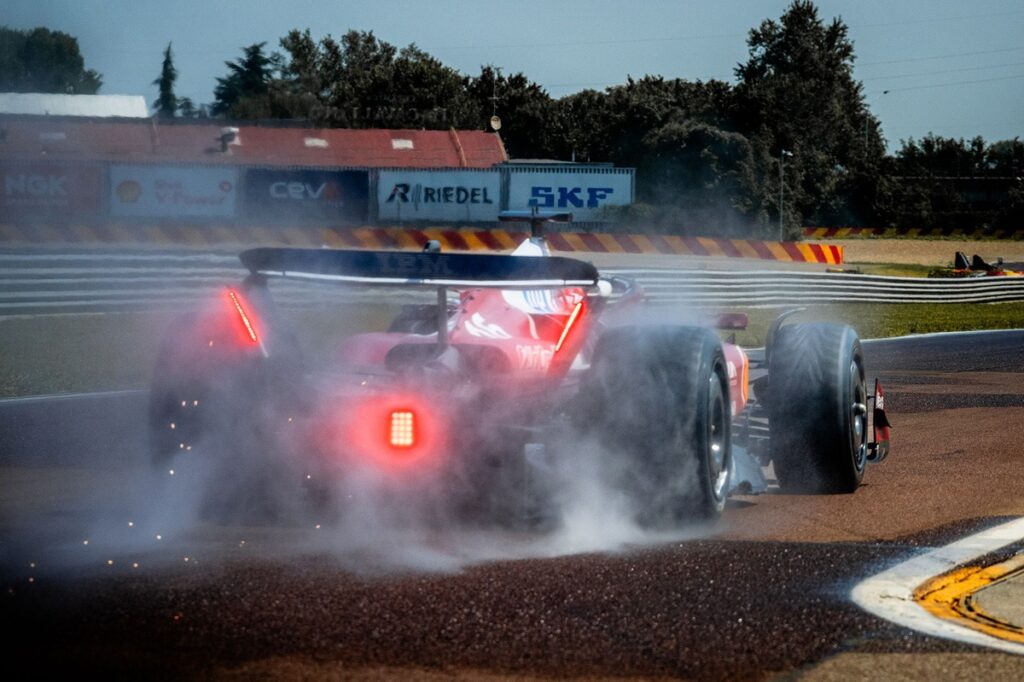At racing speeds, one of Pirelli’s blue-sidewalled ‘wet’ tyres can displace a remarkable 85 litres of water per second. The problem is that you’re more likely to see a blue moon than witness an F1 wet tyre operating at racing speeds.
That amount of water being displaced at all four corners of an F1 car adds up to a lot of spray, so the kind of circumstances that play to the wet tyre’s particular set of skills usually result in a red flag. It’s a situation that has played out on several occasions in recent years, most absurdly in Belgium in 2021 and most recently in Sao Paulo last year. At the Brazilian race, drivers trickled around on intermediates, preferring to wait for the inevitable stoppage rather than sacrificing track position by pitting for wets.
One of Pirelli’s focuses for the next-generation tyres, which will be fitted to next year’s all-new cars, is to move the wet tyre’s performance closer to the intermediate. Currently, it overheats and degrades quickly in anything other than red-flag-inducing conditions – indeed, it has only seen service once so far this season, and then briefly only briefly when Carlos Sainz ran the blue-walled wets on his Williams in the Miami sprint.
“I believe we are now in quite a good situation,” said Pirelli motorsport manager Mario Isola. “The intermediate tyre was already more or less defined [for 2026]. We have to validate some new solution of the extreme wet.
“Especially trying to have a crossover [point between wet and intermediate] in a different position compared to now. To make the extreme wet tyre more usable. Not just behind the safety car, but a proper race tyre.
Pirelli wet tyres
Photo by: Jake Grant / Motorsport Images
“We know that the issue with the extreme wet is visibility anyway. So, we are not going to fix this issue. But both the intermediate and the wet now are okay.”
Validating the 2026 wet and intermediate compounds was the focus of a Pirelli test at Ferrari’s Fiorano circuit late last week with Charles Leclerc and Zhou Guanyu, who both used a ‘mule car’ to simulate the likely loadings induced by the next-generation cars. The downside of this is that using mule cars renders the process fundamentally inexact, and the summer weather in Emilia-Romagna failed to oblige.
The ideal ‘crossover point’ when one tyre becomes more favourable than another in changing conditions is quite subtle. Usually, the point at which it becomes wet enough to change from slicks to intermediates is when lap times slow to 112% of the dry pace. The previous-generation Pirelli wet only became a useable proposition at the 120% point.
For this season, Pirelli introduced a new specification of wet tyre, with a different compound intended to be less thermally sensitive, and a new tread pattern that was intended to have less movement under lateral load. But it was unable to perform like-for-like testing ahead of the new season and the new tyre proved to have a crossover in the region of 118% – close to Pirelli’s 116% target, but no cigar. For 2026, the Italian manufacturer is trying again.
“Now it [the crossover between intermediate and wet] is 118% [of the dry-weather laptime],” said Isola. “We would like to go down to 116% or 115%, something like that.”
In this article
Be the first to know and subscribe for real-time news email updates on these topics
Subscribe to news alerts
Read the full article here

